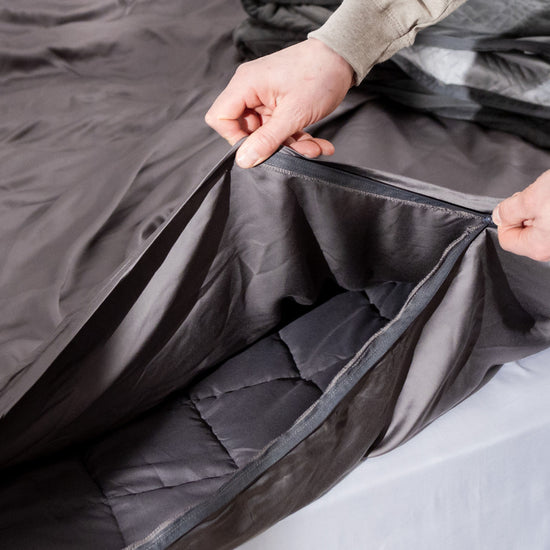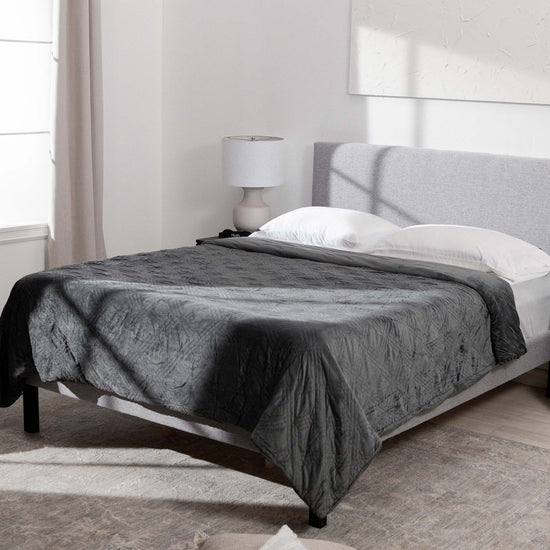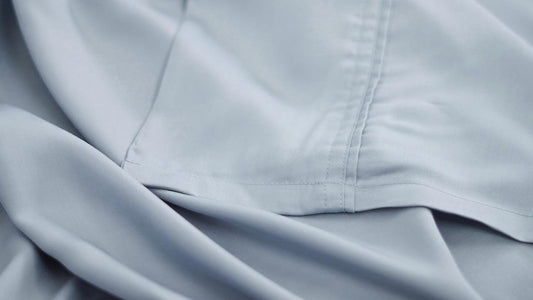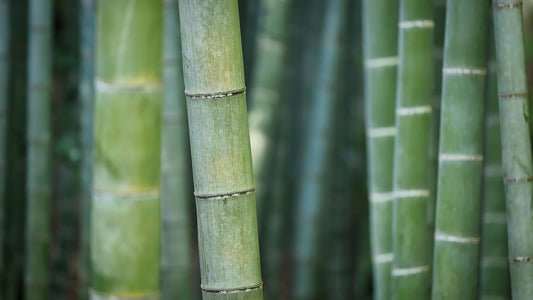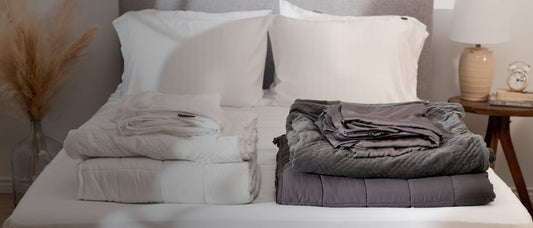There are many factors that contribute to how bed sheets feel – thread count, weave, finish, other special features, etc. – but the most important factor may be the material itself. Sheets can be made of bamboo, cotton, linen, and/or a wide variety of other materials. With so many options, how are you supposed to decide?
We’re here to help! In this article, we’re going to tell you everything you need to know about different types of bed sheets. Read on to learn about our top nine picks for the best material for bed sheets, and how to choose the right bed sheet material for you.
At a glance:
Best Material for Bed Sheets
In this section, we’re going to tell you everything you need to know about these eight popular bed sheet materials. As you’ll see, each type of material has its own unique benefits and drawbacks, so the right material for you will depend in part on which benefits you’re most interested in and which drawbacks you’d like to avoid.
Bamboo: Silky and Cooling

Bamboo is one of the most luxurious materials you can use to make the best bed sheets. Bamboo sheets have a soft, silky feeling and are durable and long-lasting. What’s more, they are cool to the touch. They’re also heat and moisture wicking, making them a great choice for hot sleepers.
By the way, even if you’re not a hot sleeper, you may be interested in trying cooling sheets. According to the Cleveland Clinic, the ideal temperature to promote sleep is around 60 to 67 degrees Fahrenheit. Even if you’re able to keep your bedroom this cool, you might still benefit from cooling sheets, which can limit overheating from trapped body heat.
Not only is bamboo soft, cooling, and durable, but it is also naturally wrinkle-resistant and static free. And WebMD says there’s some evidence that bamboo is hypoallergenic and antibacterial (though more research is needed to confirm this). In any case, it seems bamboo is much less likely to trigger an allergic reaction than many other materials.
The main drawback of (most) bamboo bed sheets is the price. These are luxury sheets, as the price tag often reflects. Thankfully, you can get luxury bamboo sheets that are more affordable from Hush. Our silky bamboo sheets are about half the price of typical luxury bamboo sheets, and they’re an especially good choice for hot sleepers and those with sensitive skin.
But don’t let the price tag fool you: These are luxury bed sheets. At Hush, we’re very picky about our materials, and our sheets are made from 100% organic viscose bamboo. We make sure it’s harvested at just the right time of year to get the full benefit of its cooling natural fibers. And we don’t use any caustic chemicals in our finishing process (unlike many other bamboo sheets).
Our Hush sheets have a thread count of 300, but because of our unique, all-natural graphite finishing process, it feels more like a thread count of 1,500. The sheets come in eight different shades, so you can find the perfect set (or sets) to match your bedroom. And they also come with a one-year warranty, though you can choose a longer warranty if you’d like.
Egyptian Cotton: Flexible and Durable

Egyptian cotton is grown in Egypt (hence the name), which has an ideal climate for growing cotton: hot and dry. When it comes to bed sheets, Egyptian cotton is another high-end choice. These sheets are luxuriously soft, durable, and very flexible. The extra-long fibers give them additional flexibility other cotton sheets don’t have.
This is because Egyptian cotton is handpicked, which allows the cotton fibers to maintain their shape and length. Egyptian cotton also has cooling properties (though it isn’t as cooling as bamboo). It is very soft to the touch, and it is said to be hypoallergenic. That said, like all cotton, Egyptian cotton is not wrinkle-resistant, so you’ll have to be careful with it to avoid wrinkles.
As these are considered luxury sheets, they tend to have a high price tag. They can be anywhere from a few hundred to a few thousand dollars, and what’s more, not all manufacturers are honest about how much Egyptian cotton is actually in their sheets. But if you have the budget, these are a great option – just make sure you’re buying real Egyptian cotton.
For what it’s worth, Egyptian cotton tends to be a bit overrated in our experience, and you may find Pima cotton (discussed next) just as soft and luxurious.
Pima Cotton: Soft and Durable

There are two kinds of pima cotton, and both make very luxurious bed sheets. Both are named for the Native American Pima tribe, who have been growing cotton in what’s now Arizona for many centuries.
Pima cotton sheets are made from cotton grown in the southwestern US, Peru, Israel, and Australia – all of which have hot, dry climates. Like Egyptian cotton, Pima cotton is often handpicked, making it very flexible and durable. Pima cotton bed sheets have the soft, luxurious feel of Egyptian cotton, but they’re generally less expensive.
Supima cotton sheets are so-called because the name combines “superior” and “Pima.” They’re grown exclusively in the southwestern US. They’re more expensive than Pima sheets, but the standards for growing Supima cotton are higher. To be considered Supima cotton, the cotton fibers must be extra long, at least 1.5 inches.
Both Pima and Supima cotton have cooling properties, and both are considered hypoallergenic. As with Egyptian cotton, though, sometimes products are mislabeled, claiming to be 100% Pima or Supima cotton when in fact they’ve been combined with cheaper types of cotton.
A product that has a genuine Supima trademark has to be made with 100% Supima cotton. If you don’t see this trademark on Supima cotton sheets, try looking up more information about the company to be sure.
Upland Cotton: Soft and Inexpensive

Most cotton sheets are made of upland cotton, and it’s also a popular choice for clothing. If a label says “cotton” but doesn’t specify Egyptian, Pima, or Supima, chances are it’s upland cotton. Upland cotton sheets are your least expensive option for cotton sheets, and like all cotton sheets, they are generally soft and breathable.
However, Upland cotton sheets are less strong, durable, and flexible than the more expensive options we looked at above. This is because the cotton fibers are shorter than those used to make Egyptian, Pima, and Supima cotton sheets. So, Upland cotton sheets likely won’t last as long as more high-end cotton sheets.
Upland cotton is still very soft and comfortable, and it’s a great choice for those on a budget, or who prefer not to spend a lot of money on bed sheets. Upland cotton sheets are one of the most affordable options on this list.
Microfiber: Stain-resistant and Inexpensive

Another very affordable option is microfiber. Microfiber sheets are typically made from a combination of polyester, nylon, and wood pulp. As polyester and nylon are synthetic materials, those with sensitive skin may find them more irritating than organic cotton sheets, but you can also find microfiber sheets that are made from natural materials.
One of the biggest advantages of microfiber is that it is stain-resistant. In fact, many cleaning cloths and materials are made from microfiber. It’s a good choice for those with children, or who like to eat and drink in bed. Microfiber sheets are also wrinkle-resistant and moisture-wicking, and they’re very soft.
As the weave used to make microfiber is tighter than that of cotton, it’s not as breathable as cotton, and it also has a tendency to attract things like pet hair and lint. But if you’re a cold sleeper or live in a cold climate, you may like microfiber sheets, which will generally keep you warmer than cotton. You can also keep them around for use during the coldest months.
Silk: Cooling and Hypoallergenic

There’s a reason we use the word “silky” to describe things that are soft: Silk is one of the most luxurious materials available. Silk sheets are soft, smooth, cooling, and of course very silky. It is also a great choice for those with allergies or who have sensitive skin.
Silk is made from cocoons spun by silkworms, which are then harvested and boiled in hot water. This kills the silkworms, so those who follow a vegetarian or vegan lifestyle may wish to avoid silk. Some silk makers use a process that keeps the silkworms alive, though some still have issue with the practice.
Silk sheets are very cool to the touch and naturally moisture-wicking, so they’re a good choice for hot sleepers. They are considered by many to be the most luxurious sheets on the market.
As silk sheets are so luxurious, do not expect them to be cheap. In fact, they’re one of the most expensive options on this list. They are also delicate and need to be treated with care – they should only be washed in cold water and never put in the dryer. But if you can afford it and want to treat yourself to the silkiest sheets available, go ahead and give these a try.
Linen: Cooling and Durable

Linen sheets are made from the fibers of the flax plant, which tend to be stronger than cotton fibers. The most high-quality linens come from Europe, specifically Belgium, which has an ideal climate for growing the flax plant.
Linen sheets are known for being very breathable and cooling, and they’re also moisture-wicking, making them a great choice for those who prefer cooling sheets. While they tend to be a little stiff at first, they’ll get softer over time, and they’re very durable and long-lasting.
Linen sheets tend to be expensive, but you can often find cotton/linen blends that are less expensive. They’re also not wrinkle-resistant, so extra care will need to be taken if you want to avoid wrinkles. And, they get even softer and more comfortable with each wash while maintaining their strength and durability.
Flannel: Warm and Inexpensive

Flannel is made from a combination of wool, cotton, and other materials. The weave is much denser than pure cotton or most other types of fabric. Flannel sheets are known for being very warm: The fabric is thick and insulating. As such, it’s a great choice for the colder months, or those who tend to get cold at night.
Flannel sheets are soft, cozy, and very comfortable. Flannel is also strong and durable, and it is naturally wrinkle-resistant. Additionally, flannel is one of the more budget-friendly fabrics on this list. You won’t have to spend a lot of money on a nice new set of flannel sheets, and you won’t need to pair them with an expensive comforter to keep you warm.
The main drawback of flannel is not breathable or moisture-wicking. If you have a tendency to wake up sweaty, you may want to avoid flannel, even during the colder months. But if you’re looking for something warm, soft, and inexpensive, flannel is the way to go.
Lyocell: Cooling and Drying

Compared to cotton, lyocell is more cooling, moisture-wicking, and breathable. Lyocell bed sheets are made from wood pulp, mostly from eucalyptus, oak, and birch trees. They have a very cooling feel and are ultra-absorbent, making them a great choice for those who tend to sweat during the night.
Lyocell is considered a type of rayon fabric. This means it begins with wood pulp but goes through chemical processing. However, unlike some other synthetic fabrics, the production of lyocell doesn’t create any harmful byproducts. It’s considered a semi-synthetic fabric.
Lyocell bed sheets tend to be expensive, on par with some of the more luxurious fabrics on this list. If you can find a lyocell blend – often containing cotton and/or polyester – these tend to be much less expensive. But it’s worth trying pure lyocell if you want very cooling sheets and have the budget.
Polyester Fabric: Inexpensive and Durable

Polyester sheets are the least expensive option on this list. They’re less common than cotton sheets, but they are still fairly popular and widely available. Polyester is a synthetic fiber, and it is mostly made from petroleum.
In addition to being very affordable, polyester is durable and stain-resistant. It is also water-resistant and wind-resistant, and as such, it’s a popular choice for inexpensive athletic clothing and rain apparel. It’s also soft, though it isn’t as soft as cotton (or any other material on this list).
The downsides of polyester are that it generally has a rougher feel and is less breathable than cotton and other fabrics. And as a petroleum byproduct, it’s not hypoallergenic or eco-friendly. Polyester is often blended with cotton to make a fabric cheaper than cotton but softer than pure polyester. However, those with sensitive skin may prefer to avoid polyester altogether.
How to Find the Right Bed Sheets for You

As we’ve seen, there are many things to consider when deciding on a new set of bed sheets. How much money you’re able and willing to spend, the sensitivity of your skin, whether you tend to sleep hot or cold, and other preferences are all relevant factors in determining what sort of fabrics are best for you.
For the most inexpensive options, go with polyester fabric, Upland cotton, microfiber, or flannel. For warm sheets, try microfiber or flannel. If you’re looking for cooling sheets, bamboo, lyocell, linen, or silk are all great choices. If you want something stain-resistant, try microfiber or polyester, but you may want to avoid these if you have sensitive skin.
If you want to splurge on luxurious sheets, go with bamboo, silk, linen, Egyptian cotton, Supima cotton, or lyocell. For a slightly less expensive option that is still very luxurious, try Pima cotton. But if you don’t want to sacrifice quality for price, try our Hush bamboo cooling sheets.
We pride ourselves in making luxury bamboo sheets for a fraction of the price of typical luxury sheets. In fact, like linen sheets, these sheets will actually get softer over time. With each wash, they’ll become even more comfortable without losing any of their flexibility. These sheets are meant to last a long time.
Our bamboo sheets come in five sizes: twin, twin XL, full, queen, and king. We offer eight different colors that span a wide range of the color spectrum, so you can find that perfect shade for your bedroom.

